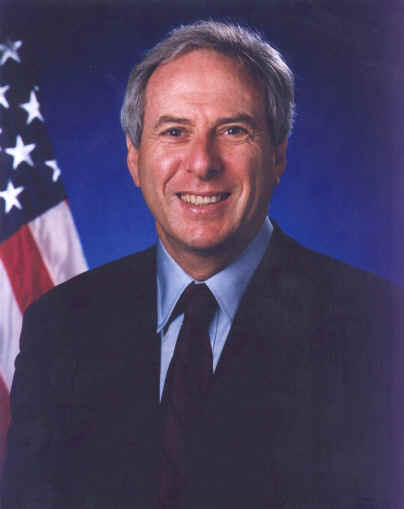
Daniel Goldin
(1940 - )
Daniel Goldin was born in New York City and grew up in the South Bronx. His father and an uncle encouraged the young boy's interest in space and rocketry. Goldin received a Bachelor of Science degree in mechanical engineering in 1962 from the City College of New York. He began his career as a research scientist at NASA's Lewis Research Center in Cleveland, Ohio, where he worked on electric propulsion systems for interplanetary travel.
In the late '60s, he left NASA to work at the technology conglomerate TRW. Over the next 25 years he rose to be Vice President and General Manager of TRW's Space & Technology Group in Redondo Beach, California. During his career at TRW, he successfully managed the development and production of advanced spacecraft, technologies and space science instruments.
While at TRW, and later as the NASA Administrator, Goldin received the Meritorious Award from the National Association of Small and Disadvantaged Businesses for his work in reaching out to minorities. Goldin was the first repeat winner of this award.
President Clinton chose Daniel Goldin to be the ninth NASA Administrator in April 1992. Goldin's first initiative was to bring NASA's budget process under control. He created a series of management teams to find ways to operate programs faster, better and cheaper without compromising safety. Within a year, NASA's five-year spending plan was reduced by $15 billion, the equivalent of an entire year's funding. Since that time, NASA has reduced its long-range spending plans by almost $30 billion. The budgetary reforms streamlined major programs, while some of the savings were reinvested in improvements to NASA's science and planetary exploration missions.
Under Goldin, the Discovery Program, an entirely new class of planetary probes, was inaugurated. The goal of the program is to reduce development time to less than three years, and mission costs to less than $150 million. During the same period, Goldin launched a series of procurement and management reforms to make the Agency more businesslike. He simplified and expedited procedures for awarding contracts, instituted a "yellow light" system that triggers stringent internal reviews even at the threat of cost overruns, expanded contracting opportunities for small and disadvantaged businesses, and set up independent panels to ensure that cost and schedule estimates are as accurate as possible.
With the active support of the White House, Goldin also moved boldly to promote significant new cooperative endeavors with the Russian Space Agency. Today, Russia is a full partner in the International Space Station program, a move that enables the project to be completed sooner and at less cost to the American taxpayer.
Another major challenge for Goldin was the redesign of the Space Station program. The challenge was to significantly cut costs without sacrificing meaningful science or technology development capability for the orbital laboratory. Goldin formed a redesign team in 1993 which worked intensively to identify a series of less expensive options for the Clinton Administration to consider. The President chose a derivative of the old Space Station Freedom design in June 1993 and restated his strong support for the project.
Overall, Goldin's team cut the life cycle costs of the space station by $15 billion. In 1993, with Space Station redesign issues still being resolved, the program was approved by a one-vote margin in the House of Representatives. In the summer of 1994, with the improved design and the addition of Russia as a full partner, the project passed by a 123-vote margin in the House, one of the most remarkable political turnarounds in recent memory.
Goldin's reforms weren't limited to the Agency's space agenda. He also spearheaded President Clinton's revitalization of NASA's aeronautics program. A critical industry for America, aeronautics was responsible for almost a million high-tech jobs in the 1990s. This effort increased investments and technical progress in general aviation, subsonic transports, supersonic and hypersonic flight technology, and revitalized aging research facilities such as wind tunnels.
Goldin also put in place a series of internal review teams to exhaustively prepare for the Space Shuttle mission in December 1993 to repair the Hubble Space Telescope. The repair work was a brilliant success, and only a few months later in the spring of 1994, the telescope provided the most convincing evidence yet of the existence of black holes and the formation of planets around distant stars.
Since leaving NASA in 2001, Daniel Goldin has been engaged in robotics research at the Neurosciences Institute in La Jolla, California. He is a Fellow in the American Institute of Aeronautics and Astronautics and a Fellow in the Institute for the Advancement of Engineering. In 1993 he received the John F. Kennedy Astronautics Award from the American Astronautical Society and the Space Pioneer Award from the National Space Society. He is married to the former Judith Linda Kramer of New York City. They have two daughters.
Courtesy of:
